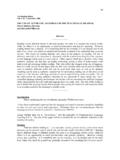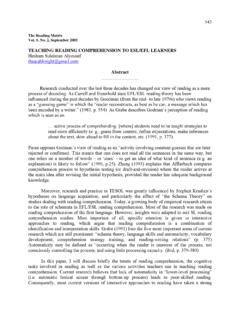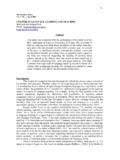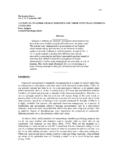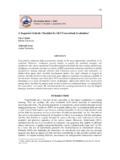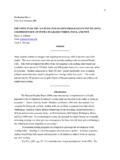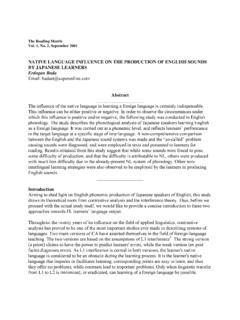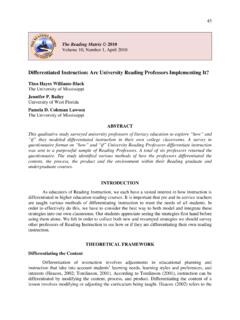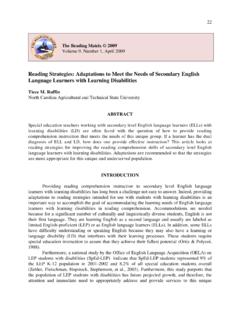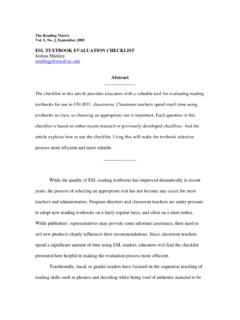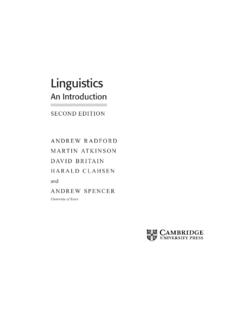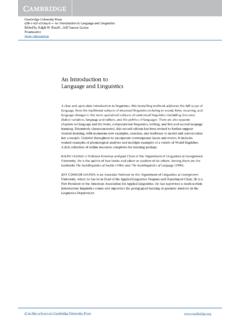Transcription of Introducing Sociolinguistics - Reading Matrix
1 The Reading Matrix Vol. 8, No. 2, September 2008 Introducing Sociolinguistics Miriam Meyerhoff Routledge, Oxon, Oxford (2006) Pages: xxiii + 320 ISBN: 0-415-39947-5 Cost: $ 40 Reviewed by Handoyo Puji Widodo Indiana University of Pennsylvania, PA, USA In the recent language pedagogy, sociolinguistic competence has been increasingly crucial owing to the growing need for intercultural communication (Savignon & Sysoyev, 2002; Savignon, 2003). For this reason, Introducing Sociolinguistics by Miriam Meyerhoff provides language classroom teachers fundamental sociolinguistic issues to be included in language curriculum and course design and development. Furthermore, undergraduate and graduate students in TESOL/Applied Linguistics programs taking Sociolinguistics courses should consider the book as a starting point for learning Sociolinguistics in general.
2 This volume addresses key sociolinguistic issues like (a) language variation, style, and attitudes in social milieus; (b) politeness; (c) language and gender; and (d) language contact. Each of the chapters includes (1) exercises that allow readers to interact critically with the text, (2) notes that make connections between Sociolinguistics and linguistic/social theory, and (3) short, lively add-ons tailored to make the book a memorable and enjoyable read. Each of the chapters also has key terms that help readers predict what issues will be treated and navigate such issues easily. Furthermore, with a glossary of key terms, readers unfamiliar with the field find the book friendly-reader. In Chapter I, Meyerhoff provides readers clear-cut information on the definitions of Sociolinguistics , the way sociolinguists study this area, making connections between Sociolinguistics and other related fields, Sociolinguistics questions, structure of the book, and understanding Sociolinguistics on quantitative and qualitative bases.
3 Chapter II basically treats how a particular language varies from one region to another, and why certain speakers of a language use different language styles. In short, the author has fruitfully examined solid theoretical and historical grounds that help readers become acquainted with how and why speakers of a certain language alternate between different language varieties or different norms within a particular variety. To complement Chapter II s discussion of linguistic variation, the third chapter gives readers crucial information on stylistic variation in the speech of a single speaker in which this information serves as a locus of sociolinguistic inquiry. More crucially, the author has successfully examined how and why speakers attune their speech based on the addressees perceived norms.
4 These provide a considerable basis for analyzing style-shifting studies. Chapter IV provides more detailed foundation for the style-shifting treated in Chapter III. The author generally examines how speakers use language as a scaffold for formulating and expressing attitudes towards others. Meyerhoff has also successfully explored how people s attitudes to language and language users can be employed to complement traditional maps of regional dialects. She has, in some detail, looked at such crucial linguistic notions as linguistic relativism, social identity theory, and accommodation theory. Thus, Meyerhoff has provided substantial issues on how people perceive a certain language. In the fifth chapter, Meyerhoff has shed detailed light on one of the pragmatic issues, politeness theories derived from the Brown and Levinson s framework.
5 The author argues that such issues can, in some ways, be construed as sociolinguistic variables. She perceives politeness as a feature of language much affected by cultural and societal norms/expectations commonly expressed and realized between individuals. In this regard, the author has given readers with valuable information on how politeness strategies are used to negotiate a position for a speaker in relation to others in the complicated social space. To sum up, the author has eloquently shown readers how politeness strategies differ across language and across culture. The sixth chapter highlights (a) how speakers within multilingual communities decide which a language to use and when to use it; (b) how institutions and nations have engaged in the recognition and validation of different language varieties; and (c) how a language is widely used within a certain community, and how it will be preserved in successive generations.
6 Interestingly, the author introduces the concept of ethnographic vitality that any languages can be well-preserved due to these three factors (a) status economic, social, socio-historical, and linguistic; (b) demography the numbers of speakers; and (c) institutional support either formal or informal. Other fascinating issues in the chapter include code-switching, code-mixing, and speech levels, which are contributing factors of how speakers make a choice of using a particular language. Thus, Meyerhoff emphasizes how speakers with multilingual abilities would rather use a certain language, which fits well with their social milieu. In Chapter VII, Meyerhoff carefully examines how languages alter or develop as their speakers grow. It means that the language the speakers used during their childhood are different from that during their adulthood because the speakers have more language input from wider social interaction with others.
7 It can be implied that the more mature the speakers are, the more complex language they encounter. In Chapters VIII and IX, the author has successfully pulled together how social class and social networks affect linguistic variation in a certain community of practice as a whole. First, she has provided practical and theoretical reasons why broad categorizations like social class should be considered part of the sociolinguistic tool kit. Meyerhoff, further, eloquently examines two levels of social categorizations like social networks and communities of practice. She argues that both can serve as the basis for analyzing language variation and change. Thus, Meyerhoff casts fundamental light on how language is shaped based on social networks and communities of practice. The tenth chapter succinctly highlights how a language varies based on gender.
8 The interesting point is that the author highlights the gender paradox ( , women use the standard more than men and women use more of the incoming variant than men). Meyerhoff points out that such a paradox took place owing to serious problems with how gender had been defined as a variable in the previous social dialect work. To summarize, the author allows readers to have an appealing journey of a gender issue in language use. In the eleventh chapter, the author has fruitfully reviewed several case studies on the impacts of language contact between different varieties of English and that between quite different languages resulting in the creation and development of pidgins/creoles. This chapter, more crucially, informs readers of whether increasing globalization and cross-linguistic contact affect the structure and vitality of languages in the multilingual world driven by status, demographic, and institutional factors, as discussed in Chapter VI.
9 Thus, Meyerhoff has fruitfully stressed the importance of language contact in further development of languages where multilingual phenomena take place. In the last chapter, Meyerhoff invites readers to further think of the following indispensable issues: (1) the centrality of spontaneous speech of sociolinguistic data, (2) the centrality of variation in the way speakers use language to the grammar of a speech community, (4) the needs for our analyses to draw on non-linguistic factors that are useful in the particular communities being studied, and (5) the motivations we ascribe to speakers use of different forms in speech (p. 265). This chapter challenges other sociolinguists to find out new directions for such issues so as to enrich sociolinguistic horizons. Although this book addresses pure sociolinguistic issues, it is useful for language classroom teachers who wish to incorporate such issues into their language course syllabi and curricula to equip their learners with sociolinguistic competence.
10 On the whole, Miriam Meyerhoff s Introducing Sociolinguistics offers readers an easy-to-navigate, reader-friendly, and well-informed resource for an introductory course on Sociolinguistics and the useful basis for language course and curriculum design. References Savignon, (2003). Teaching English as communication: A global perspective. World Englishes, 22, 55-66. Savignon, , & Sysoyev, (2002). Sociocultural strategies for a dialogue of cultures. The Modern Language Journal, 86, 508-524. Handoyo Puji Widodo, a tenured lecturer at Politeknik Negeri Jember, has taught EFL courses in Indonesia, and is currently a Fulbright scholar working on an MA in TESOL at Indiana University of Pennsylvania. He has published a number of articles and book reviews in refereed professional journals in the areas of ESP and language teaching methodology in Indonesia, India, Korea, New Zealand, Singapore, and USA.
